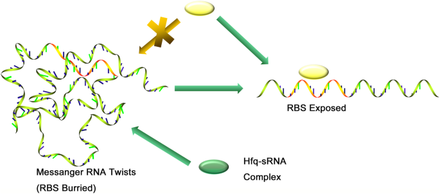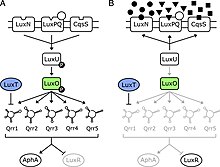Qrr RNA
| Quorum regulatory RNA | |
|---|---|
 | |
| Identifiers | |
| Symbol | Qrr |
| Alt. Symbols | Qrr1–5 |
| Rfam | RF00378 |
| Other data | |
| RNAtype | sRNA |
| Domain(s) | Vibrio |
| PDBstructures | PDBe |
Introduction
[edit]Qrr(Quorum regulatoryRNA)[1]is a smallnon-coding RNAthat is thought to be involved in the regulation ofquorum sensinginVibriospecies. The use of small RNAs for vital functions like metabolism, infection cycling, and stress response is ubiquitous among bacteria.[2]Qrr operates as part of anegative feedbackloop which regulates the shift in cell state from that of low density populations to that in high density populations.[3]This feedback system allows for rapid responses to changes in population cell density, eliminating the production of energy-costly molecules.[4]It is believed that these RNAs, guided by aprotein,Hfq,can mediate the destabilization of the quorum-sensing master regulators LuxR/HapR/VanTmRNAs.[2][5]This group of non-coding RNAs are trans-acting small RNAs (sRNAs) that bind via base pairing to the untranscribed domain of theirmRNAtargets. This binding results in degradation or stabilization, deciding their translational fate.[6]
Qrr RNA Characteristics
[edit]Genes, Expression, and Mechanism
[edit]There are 5 differentqrrgenes(Qrr1–5) inV. harveyi;of these,qrr2,3and4are activated by LuxR.[5]OtherVibriospecies contain varying number of these genes, with overlapping functions and promotion.[6]Each of these Qrr RNAs are expressed at different times, fluctuating in level.[7]Each gene is expressed individually based on growth conditions, with unique factors and regulators controlling their respective expression.[6]For example,LuxTtranscriptionally repressesqrr1,but does not regulate the otherqrrgenes.[8]The genes are expressed in this order from lowest to highest: Qrr5, Qrr1, Qrr3, Qrr2, Qrr4.[8]

Exactly 20 mRNA targets of the RNAs have been established in Vibrio.[7]Fourregulationstrategies are utilized by these molecules through unique base-pairing interactions with mRNA targets: sequestration for luxO, coupled degradation for luxM, uncovering the RBS of aphA, and catalytic degradation for luxR.[7]Each Qrr RNA contains specific binding regions to differentiate between different mRNA targets.[9]Translation of AphA is enhanced for low cell density conditions, whereas LuxR is inhibited for high cell density conditions.[6]Qrr2was found to be unique in possessing twopromotersand utilized by other species in addition toVibrio.[6]The unique type of regulation by Qrr RNA likely produces expression patterns that protein transcription factors cannot.[4]
The protein Hfq serves as a mediator between each qrr RNA and their respective mRNA targets.[7]It also protects the unstable molecules from free degradation by RNase. Abundance of Hfq limits qrr RNA binding, as the separate RNAs compete for its safeguarding behavior.[7]
Structure and Evolution
[edit]Qrr RNAs were first identified in 2004 inbioinformaticscreenings of severalVibriospecies.[1]It is believed that the stem loop portion of the RNA structure was integral to its primordial functions, with other functionalities resulting from sequence mutations.[10]The molecule is composed of fourstem loops(loops seen in "Quorum regulatory RNA" image): two stem loops operate by base-pairing to the mRNA targets, the second also insulates the structure from Rnase E-mediated degradation, the third assists in stabilizing base-pairing, and the fourth is utilized as a terminator.[4]
Theqrrgenes share 80% sequence similarity, with predictions of analogoussecondary structures.[2]In the event of deficiency in a single Qrr RNA, the other genes are upregulated to compensate for the loss, but can also have independent functions.[2]Two known feedback loops account for the expression adjustment: HapR-Qrr and LuxO-Qrr feedback loops.[2]This functional duality give plasticity to bacteria possessing these genes, allowing them to react accordingly to environmental and communal conditions.[8]
Applications and Examples
[edit]
Quorum Sensing for Bioluminescence inV. harveyi
[edit]Detailed mechanistic pathways have been uncovered for how Qrr RNA is utilized inV. harveyifor the phenomenon ofbioluminescence.Threeautoinducers(AIs) are produced by this species: AI-1, LuxS, and CAI-1.[8]LuxN, LuxPq, and CqsS recognize these AIs, respectively. Few AIs are produced when cell density is low, which leads to aphosphorylatedLuxO, along with sigma factor 54, activatingqrr1-5expression.[8]Binding sites for these two regulators are upstream of eachqrr.[8]Post-transcriptionally, the Qrr RNAs promote the expression of low cell density master regulatoraphAand represses expression of high cell density master regulatorluxR.Their expression also inhibitors expression of theluciferaseoperon, which allowsluminescentoutput forV. harveyi.[8]The opposite phenomenon occurs in high cell density, with high AI expression and subsequent reversal ofaphAandluxRexpression levels. The luciferase operon is expressed and luminescence occurs for cell communication.[8]The phosphorylation of LuxO is key to this mechanism, not necessarilyluxOexpression.[8]
Other Functions
[edit]Novel qrr RNAs have also been investigated recently in species outside of theVibriogenus. One such RNA, AmiL, was identified inPseudomonas aeruginosa.[11]AmiL was found to be involved in virulence ofP. aeruginosa,including mammalian cytotoxicity, biofilm formation, and motility.[11]This RNA plays into a larger network of quorum sensing which has yet to be elucidated.
An additional 16 Qrr RNA targets outside of quorum sensing regulatory networks have been identified.[4]Among these are certain quorum-sensing-controlledvirulence factorsandchemotaxisreceptors, thought previously to only be regulated by protein transcription factors. Since the production of these factors taxes the cell, the rapid response regulation provided by Qrr RNA could be advantageous in energy-conserving repression.[4]
References
[edit]- ^abLenz, DH; Mok KC; Lilley BN; Kulkarni RV; Wingreen NS; Bassler BL (2004)."The Small RNA Chaperone Hfq and Multiple Small RNAs Control Quorum Sensing in Vibrio harveyi and Vibrio cholerae".Cell.118(1): 69–82.doi:10.1016/j.cell.2004.06.009.PMID15242645.
- ^abcdeSvenningsen SL, Tu KC, Bassler BL (2009)."Gene dosage compensation calibrates four regulatory RNAs to control Vibrio cholerae quorum sensing".EMBO J.28(4): 429–439.doi:10.1038/emboj.2008.300.PMC2632942.PMID19165149.
- ^Tu KC, Long T, Svenningsen SL, Wingreen NS, Bassler BL (2010)."Negative Feedback Loops Involving Small Regulatory RNAs Precisely Control the Vibrio harveyi Quorum-Sensing Response".Mol Cell.37(4): 567–579.doi:10.1016/j.molcel.2010.01.022.PMC2844700.PMID20188674.
- ^abcdeShao, Yi; Feng, Lihui; Rutherford, Steven T; Papenfort, Kai; Bassler, Bonnie L (2013-07-09)."Functional determinants of the quorum-sensing non-coding RNAs and their roles in target regulation".The EMBO Journal.32(15): 2158–2171.doi:10.1038/emboj.2013.155.ISSN0261-4189.PMC3730234.PMID23838640.
- ^abTu, K.; Waters, C.; Svenningsen, S.; Bassler, B. (Nov 2008)."A small-RNA-mediated negative feedback loop controls quorum-sensing dynamics in Vibrio harveyi".Molecular Microbiology.70(4): 896–907.doi:10.1111/j.1365-2958.2008.06452.x.ISSN0950-382X.PMC2680268.PMID18808382.
- ^abcdeTague, J. G.; Hong, J.; Kalburge, S. S.; Boyd, E. F. (2022-01-18). O’Toole, George (ed.)."Regulatory Small RNA Qrr2 Is Expressed Independently of Sigma Factor-54 and Can Function as the Sole Qrr Small RNA To Control Quorum Sensing in Vibrio parahaemolyticus".Journal of Bacteriology.204(1): e00350–21.doi:10.1128/JB.00350-21.ISSN0021-9193.PMC8765448.PMID34633869.
- ^abcdeFeng, Lihui; Rutherford, Steven T.; Papenfort, Kai; Bagert, John D.; van Kessel, Julia C.; Tirrell, David A.; Wingreen, Ned S.; Bassler, Bonnie L. (2015-01-15)."A Qrr Noncoding RNA Deploys Four Different Regulatory Mechanisms to Optimize Quorum-Sensing Dynamics".Cell.160(1): 228–240.doi:10.1016/j.cell.2014.11.051.ISSN0092-8674.PMC4313533.PMID25579683.
- ^abcdefghiEickhoff, Michaela J.; Fei, Chenyi; Huang, Xiuliang; Bassler, Bonnie L. (2021-04-01)."LuxT controls specific quorum-sensing-regulated behaviors in Vibrionaceae spp. via repression of qrr1, encoding a small regulatory RNA".PLOS Genetics.17(4): e1009336.doi:10.1371/journal.pgen.1009336.ISSN1553-7404.PMC8043402.PMID33793568.
- ^Shao, Yi; Bassler, Bonnie L. (February 2012)."Quorum-sensing non-coding small RNAs use unique pairing regions to differentially control mRNA targets".Molecular Microbiology.83(3): 599–611.doi:10.1111/j.1365-2958.2011.07959.x.ISSN1365-2958.PMC3262071.PMID22229925.
- ^Dutcher, H. Auguste; Raghavan, Rahul (2018-04-06). Storz, Gisela; Papenfort, Kai (eds.)."Origin, Evolution, and Loss of Bacterial Small RNAs".Microbiology Spectrum.6(2): 6.2.12.doi:10.1128/microbiolspec.RWR-0004-2017.ISSN2165-0497.PMC5890949.PMID29623872.
- ^abPu, Jieying; Zhang, Shebin; He, Xi; Zeng, Jianming; Shen, Cong; Luo, Yanfen; Li, Honglin; Long, Yifei; Liu, Jianping; Xiao, Qian; Lu, Yang; Huang, Bin; Chen, Cha (2022-04-27). Rather, Philip N. (ed.)."The Small RNA AmiL Regulates Quorum Sensing-Mediated Virulence in Pseudomonas aeruginosa PAO1".Microbiology Spectrum.10(2): e02211–21.doi:10.1128/spectrum.02211-21.ISSN2165-0497.PMC9045362.PMID35262393.
Further reading
[edit]- Shao, Y; Bassler, BL (Apr 3, 2014)."Quorum regulatory small RNAs repress type VI secretion in Vibrio cholerae".Molecular Microbiology.92(5): 921–930.doi:10.1111/mmi.12599.PMC4038675.PMID24698180.
- Tu, Kimberly C. (January 15, 2007)."Multiple small RNAs act additively to integrate sensory information and control quorum sensing in Vibrio harveyi".Genes Dev.21(2): 221–233.doi:10.1101/gad.1502407.PMC1770904.PMID17234887.
- Waters, Christopher M. (October 1, 2006)."The Vibrio harveyi quorum-sensing system uses shared regulatory components to discriminate between multiple autoinducers".Genes Dev.20(19): 2754–67.doi:10.1101/gad.1466506.PMC1578700.PMID17015436.S2CID6251192.
